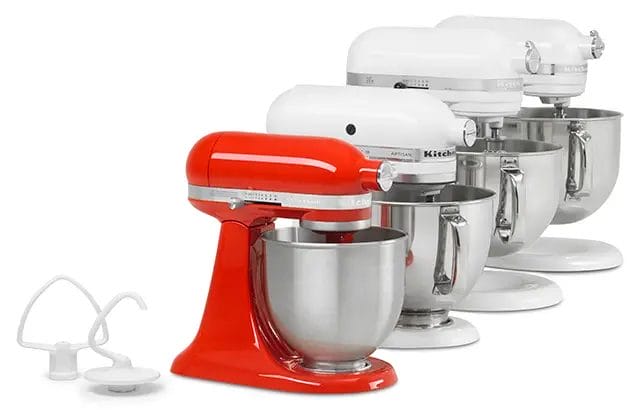It’s critical to select the right mixer to meet your baking requirements. A suboptimal choice might leave you with a machine ill-suited to handling large batches of bread or cookie dough. Let’s discuss the key considerations when choosing between tilt head and bowl lift mixers.
Tilt Head Mixers
Tilt head mixers feature a head that tilts back and forth at a joint between the stand and the head, which carries its own set of pros and cons.
Advantages
- Easy Access: The tilting head enables easy access to the bowl and effortless removal of the mixing extensions. Whether you need to add extra ingredients or scrape the sides, the tilt head feature simplifies the process.
Disadvantages
- Stability: The joint where the tilting mechanism sits can loosen and even shake during operation.
Bowl Lift Stand Mixers
Bowl lift mixers have a stationary head. The bowl is held by two clamps and attached to a crank, which you turn to lift or lower the bowl.
Advantages
- Stability: Bowl lift mixers tend to be more stable and can handle more powerful motors and tougher doughs. If you’re an intense baker, a bowl lift mixer could be the right choice.
Disadvantages
- Space: Bowl lift mixers require more vertical space, which is a critical factor if you have a smaller kitchen.
Comparison and Decision Factors
When comparing the two types of mixers, consider the following factors:
- Space Requirements: Tilt head mixers fit into tighter spaces when not in use, but they need room to lift the head. Bowl lift mixers need vertical space.
- Ease of Component Removal: It’s typically easier to remove individual components from a tilt head mixer, as the head moves out of the way completely.
- Usage Frequency and Power Needs: If you bake regularly and need a more powerful mixer, a bowl lift model may be more suitable.
- Cost: Given that bowl lift mixers often house more powerful motors, they may be priced higher.
Durability and Maintenance
Another important aspect to consider is the durability and maintenance of the mixers.
Tilt-head Mixers
- Durability: Tilt-head mixers have hinges, which are potential weak points that can wear out over time, especially if you frequently use your mixer.
- Maintenance: Cleaning tilt-head mixers is generally easier due to the ability to tilt the head and remove the bowl. However, the hinge may require occasional oiling to ensure smooth operation.
Bowl Lift Mixers
- Durability: Bowl lift mixers generally offer better durability due to their robust construction and lack of moving parts (like hinges). They are designed to handle heavier mixes and longer mixing times.
- Maintenance: Bowl lift mixers might be a bit more challenging to clean due to the fixed position of the head. However, they require less maintenance overall due to fewer moving parts.
Aesthetics
Lastly, the aesthetics can play a role in your decision:
- Tilt-head Mixers: These are often seen as more stylish and come in a wider variety of colors and finishes. If you plan to display your mixer on your countertop, a tilt-head model might be more appealing.
- Bowl-lift Mixers: While these mixers have a more industrial and professional look, they might not come in as many color options as their tilt-head counterparts. If you prefer a professional kitchen look, a bowl-lift mixer could be a better fit.
Additional Features to Consider
Beyond the basic differences between tilt-head and bowl-lift mixers, there are a few additional features that you might want to consider when making your decision:
Mixing Action: Different mixers may have different mixing actions. Some use a planetary mixing action, which means that the beater spins on its axis while also rotating around the bowl, providing thorough mixing. Make sure to check the type of mixing action of the mixer you’re considering to ensure it fits your needs.
Attachments and Accessories: Most stand mixers come with a paddle, whisk, and dough hook attachment, but some mixers have optional attachments that can extend their functionality. These can include things like pasta rollers, meat grinders, ice cream makers, and more. Consider what kind of attachments come with the mixer or are available for purchase separately.
Power and Capacity: As mentioned before, power and capacity are crucial factors to consider. If you frequently make large batches of heavy dough, you’ll need a mixer with a larger capacity and more powerful motor. On the other hand, if you only bake occasionally and in smaller amounts, a less powerful mixer will likely suit your needs just fine.
Noise Level: Some mixers can be quite noisy, especially at higher speeds. If you’re sensitive to noise or have a small kitchen where the sound could be disruptive, you may want to look for a mixer known for quiet operation.
Warranty: Since a stand mixer is an investment, check the length and terms of the warranty. A longer warranty can provide peace of mind that you’ll be covered if something goes wrong with your mixer.
In conclusion, whether a tilt-head or bowl-lift mixer is better for you depends on your individual baking needs and preferences. Both types have their pros and cons, and what matters most is finding a mixer that you’ll enjoy using and that will make your baking tasks easier. So, take your time to assess your needs and do your research to ensure you choose the mixer that’s perfect for you.
Frequently Asked Questions (FAQs)
The primary difference between these two types of mixers is how you interact with the mixing bowl and attachments. A tilt-head mixer allows the head to tilt back for easy access to the bowl, while a bowl lift mixer lets you raise and lower the bowl for access.
A tilt-head mixer tends to be smaller in size compared to a bowl lift mixer. Therefore, if you’re limited on counter space, a tilt-head mixer might be the better option for you.
While it’s not always the case, bowl lift mixers often house more powerful motors. This is due to their design, which provides more stability during operation, especially for tougher doughs or larger quantities.
Generally, bowl lift mixers are more expensive than tilt head mixers due to their larger size and often more powerful motors.
Both types of mixers are designed for durability, but the stability of bowl lift mixers can make them a bit more robust over time, especially with heavy use. However, with proper care and maintenance, both types can last for many years.



